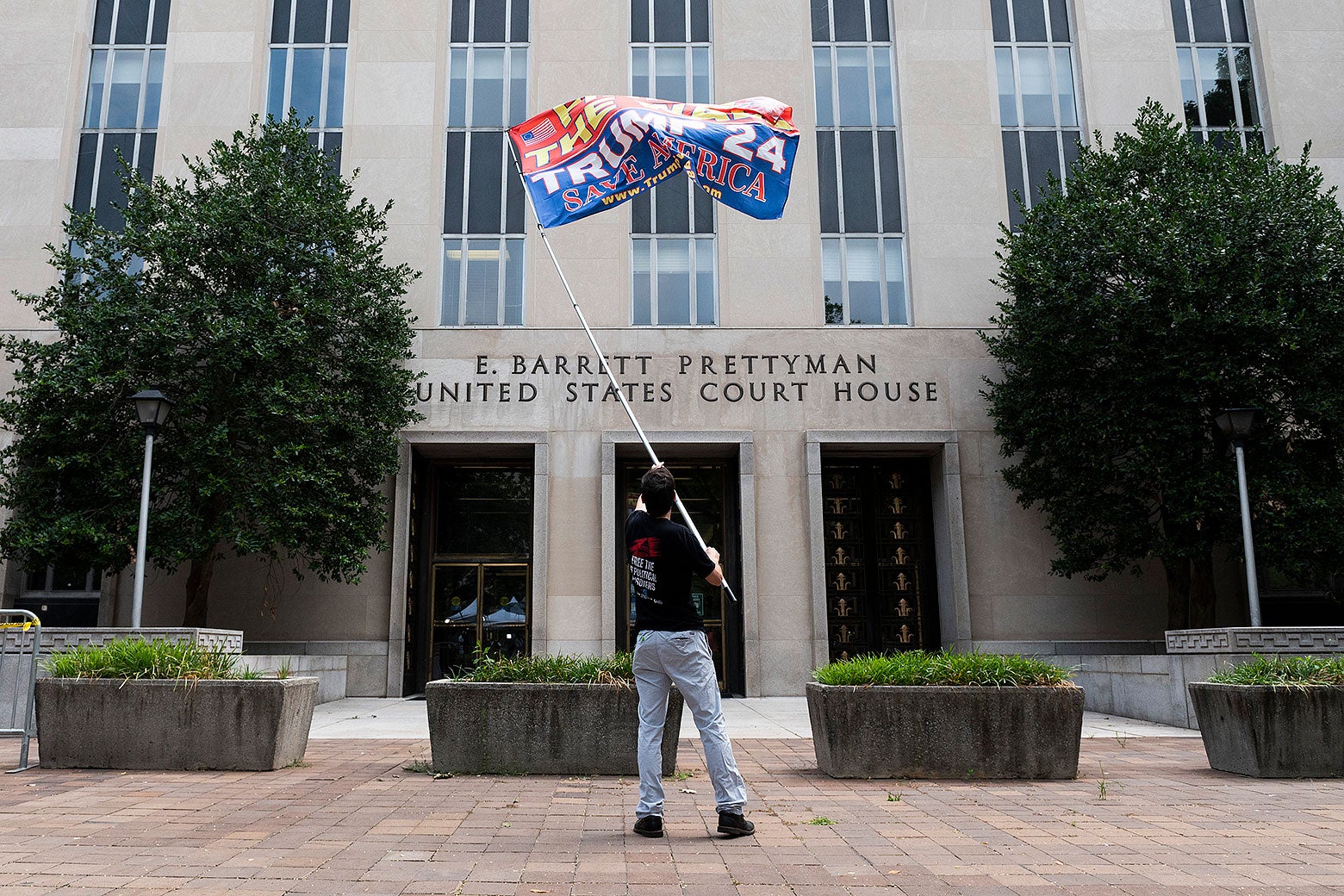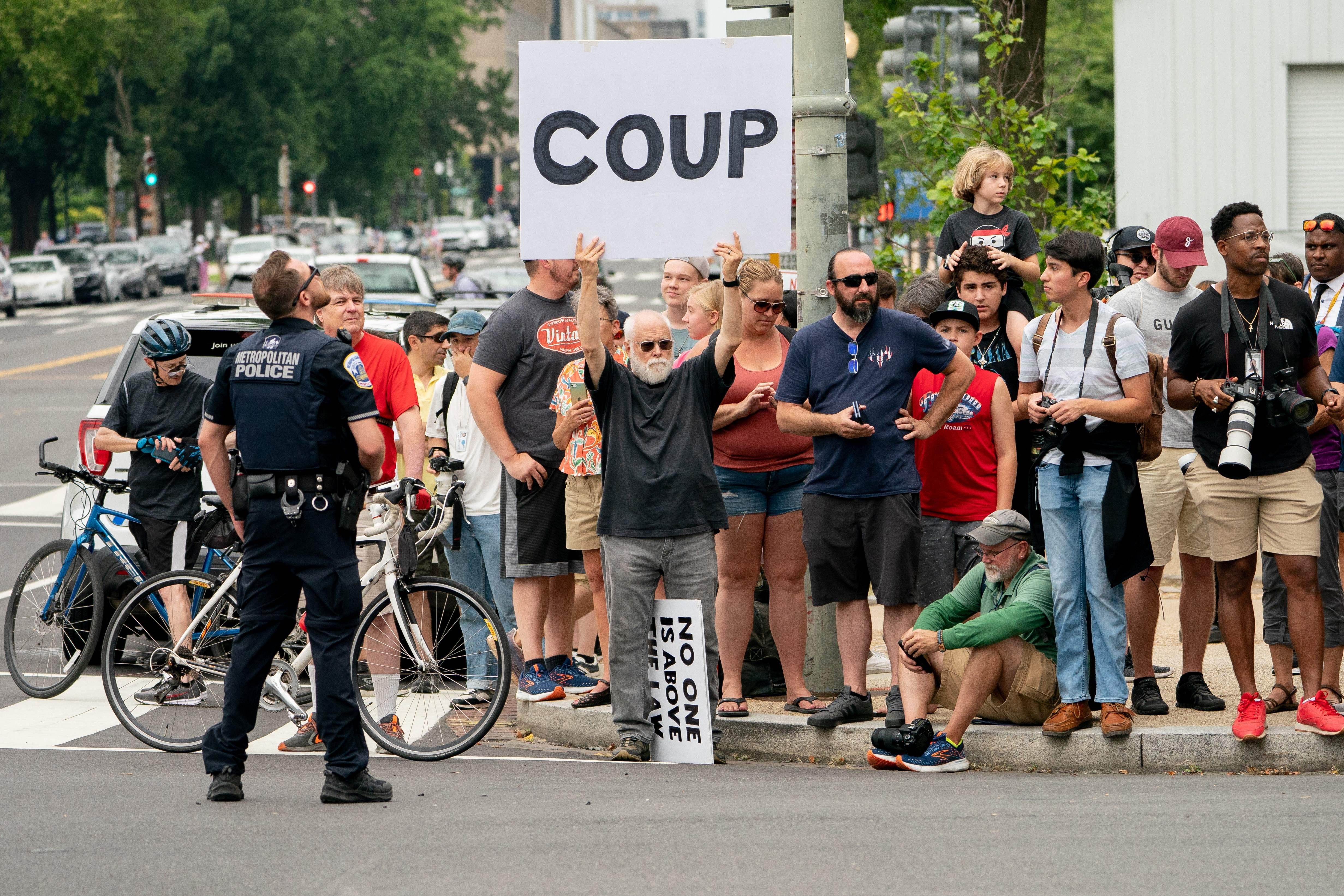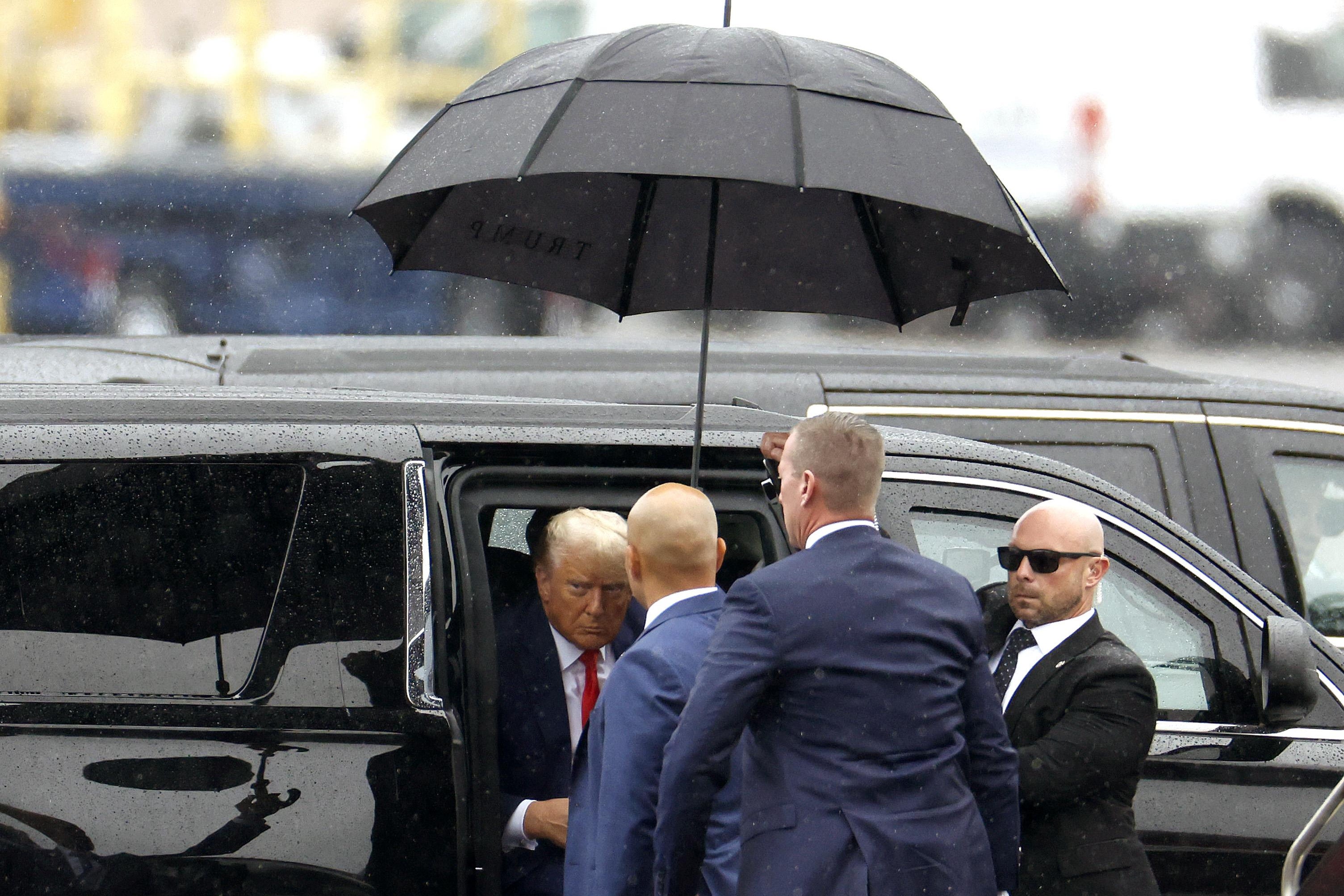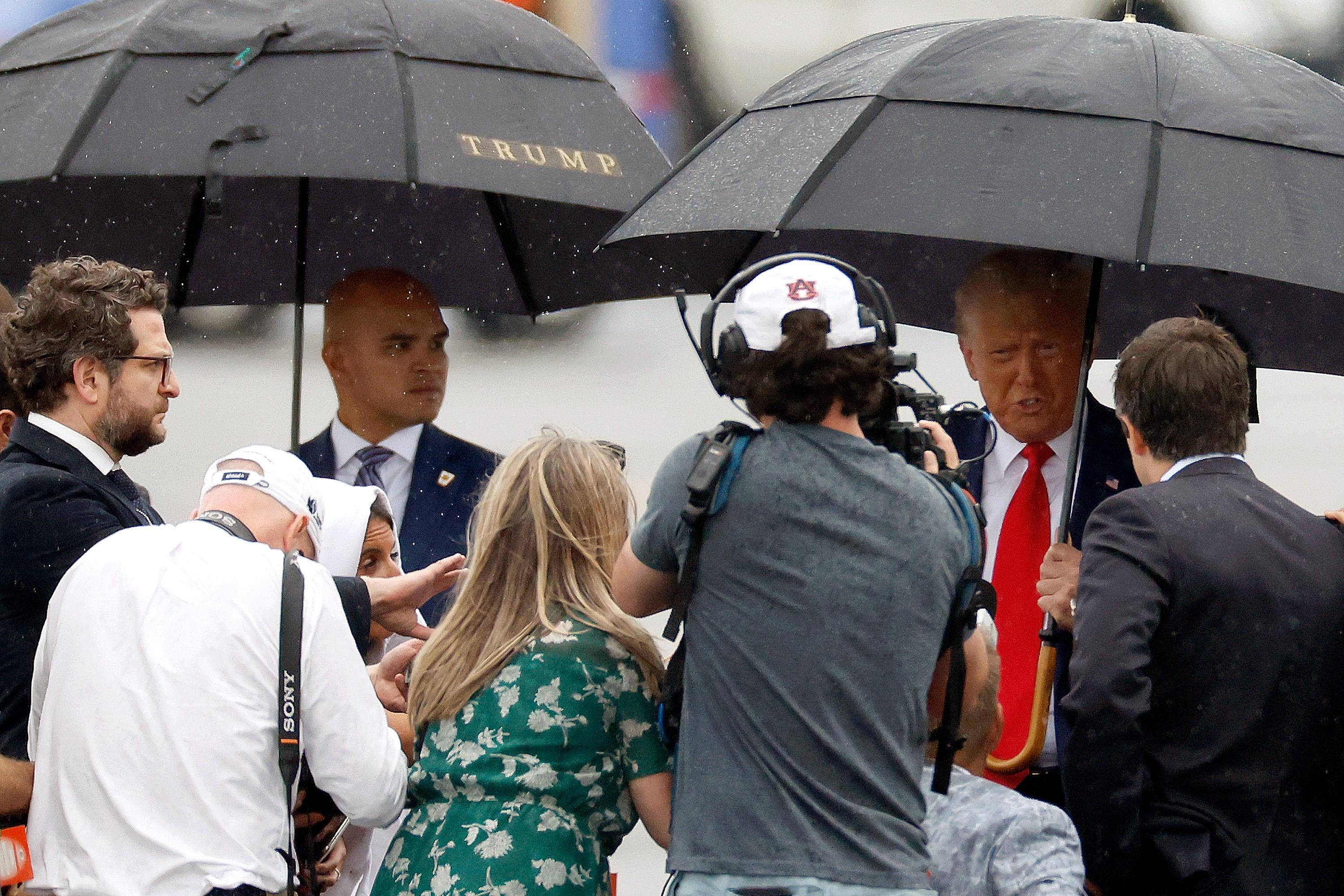Politics

Donald Trump boards his plane following an arraignment in Washington D.C. on Thursday.
Win McNamee/Getty Images
The E. Barrett Prettyman Federal Courthouse, a few blocks down Constitution Avenue from the United States Capitol, has seen its host of major trials before. But neither it, nor any courthouse, has or is likely to see a federal case on the magnitude of United States vs. Trump, for which former President Donald Trump was arraigned Thursday afternoon.
By early Thursday morning, the typically accessible building was blocked off by police—many, many police—bike racks, and yellow tape, with dump trucks positioned as an additional barrier along the east-facing 3rd Street entrance. The white-tented, farmer’s market vibe of broadcast networks’ standup spots was arrayed along the front, south-facing façade of the building, alongside dozens of vans with equipment to unload.
The media entrance, on the west side of the building, had a line at the door that started the night before—some of the major news outlets paid line-standers to hold spots for them, with reporters coming to relieve them of their duties in the wee morning hours. By 7:30, when I got in line, GOP presidential candidate Vivek Ramaswamy was already leaving, having shot his video defending Trump—his theoretical primary opponent—from charges of profound crimes against the Republic.

The courthouse.
Roberto Schmidt/Getty Images
Once inside the courthouse, though, it might as well have been any other day. There was Judge Tanya Chutkan, who will eventually preside over Trump case, grabbing a coffee from the cafeteria. She wouldn’t have to deal with the circus today, at least; the arraignment was a magistrate judge’s problem. Chief Judge James Boasberg of the District Court went down the line of reporters who were waiting to check in, shaking hands, schmoozing, cracking jokes. Was something big going down in the courthouse Thursday? You’d never know.
The arraignment was a strange thing to behold: Routine procedure, applied to a monumental moment in history.
Yes, in some ways, it’s become old hat. This was the third arraignment against the former president in a matter of months, and there may be more to come. Veteran media attendees of the previous two had their coverage routines practiced and honed; there was much talk about how D.C. courthouse’s set-up was much better organized than Miami’s—where Trump was indicted in the Mar-a-Lago documents case—a logistical experience remembered with horror. The overall tenor of the pre-arraignment coverage was staid, the muted level of drama reminiscent of a conversation overheard at the grocery store: Oh, Trump’s getting arraigned again today. Might as well be noting that the Giants were playing the Diamondbacks.
But this third case against Trump is big. These are criminal charges against a former president not for paying hush money to a porn actress or hiding classified documents behind his Florida toilet. These are federal criminal charges over Trump’s attempt to overturn an election he lost, a significant moment in American history that culminated in a riot in the United States Capitol. It’s all built up to this case.

The crowd.
STEFANI REYNOLDS/Getty Images
Still, that’s not to say that those circumstances made this arraignment, itself, exciting in the moment.
With only about 10 to 20 seats available for media and the public inside the actual courtroom, most members of the media were held in a large conference room. Four screens, each showing three camera angles of the courtroom, were projected, and staff dimmed the lights in the media room more than an hour before the proceedings began. The mood was set: we were either going to be viewing a federal arraignment or a drone strike.
The defense and prosecution sat at two oblong tables next to each other, with screens and microphones at the end of each. The special prosecutor charging the case, Jack Smith, entered the courtroom at 3:45 p.m. and took a seat on the first row of benches behind prosecution’s table, on the right. (The gallery, beyond a handful of public members and the press, also attracted a few curious D.C. federal judges in the building who came for the spectacle.)
When Trump entered the courtroom about five minutes later, he sat in the middle seat of the defense table between two of his attorneys, John Lauro and Todd Blanche. From there, he had a direct, unobstructed view of Smith sitting about 20 feet away. The former president sat with his hands folded, mostly whispering back and forth with his attorneys. Smith mostly whispered with his own associates. It was as if these two men, in the process of making each other’s lives substantially more complicated, were going out of their way to not acknowledge the other’s presence.

Former President Donald Trump, arriving at Reagan National Airport after his arraignment.
Tasos Katopodis/Getty Images
The magistrate judge, Moxila Upadhyaya, was 15 minutes late. Waiting, Trump largely stared ahead at her vacant seat.
When Judge Upadhyaya arrived, the lawyers on both sides introduced themselves, and the defense attorneys identified their client as “President Trump.”
“Good afternoon, Mr. Trump,” Upadhyaya said. He would be “Mr.” for the remainder of the hearing, including when she read him his Miranda rights.
She asked him, among other things, to state his full name.
“Donald J. Trump. John.”
And his age?
“Seven-seven,” he said, oddly.
With formalities out of the way, Judge Upadhyaya explained how things would go, saying “Mr. Trump, an arraignment is a short proceeding, but it’s an extremely important proceeding.” As if he hasn’t been through this multiple times this year already.
He pleaded not guilty.
The government didn’t request to detain Trump, but the conditions for his release include that Trump not violate state, federal, or local law. He was reminded that it’s a crime to threaten a juror, bribe a witness, or retaliate against anyone cooperating with the government. According to one pool reporter in the room, Trump appeared most irritated in this moment, shaking his head when she mentioned “arrest” as a consequence of violating these terms.

Trump, speaking with members of the media on the tarmac at Reagan National Airport, following his arraignment.
Tasos Katopodis/Getty Images
Once the initial hearing was set for August 28, there was a little back and forth between the prosecution and defense about the speed of the trial. Lauro, the Trump lawyer, insisted that his team needed to know the “scope” and “magnitude” of government’s evidence before setting a schedule going forward. Given the “weighty issues” at stake, he said, it would be “absurd” to rush such a case to trial.
“We’re going to need a little time.” And that time, should they get their way, would not be in the heat of the presidential primary.
The judge allowed for him to file a written motion making his case to Judge Chutkan, and the hearing was over. After a half-hour of sitting and behaving like a normal, well-adjusted person who might not have a proclivity for going out of his way to get into legal trouble, Trump was back at Reagan National Airport complaining about political persecution on the tarmac.
When I left the courtroom, the public presence outside the building had grown substantially. It was largely the same festival of stupid content creation that my colleague Alexander Sammon witnessed outside the Miami courthouse during Trump’s previous federal arraignment.
For example, a colonial man leading Miley Cyrus karaoke with some bros.
Next stop on the arraignment tour: Fulton County, Georgia?
Donald Trump
Jurisprudence
Law
Republicans
2024 Campaign
>>> Read full article>>>
Copyright for syndicated content belongs to the linked Source : Slate News – https://slate.com/news-and-politics/2023/08/donald-trump-arraignment-dc-federal-custody-indictment-jan-6.html?via=rss































